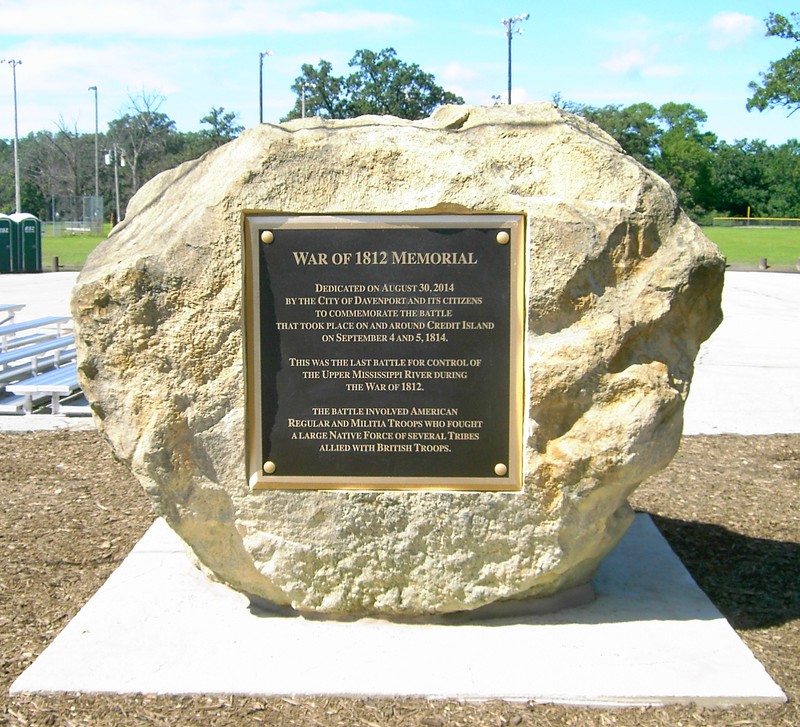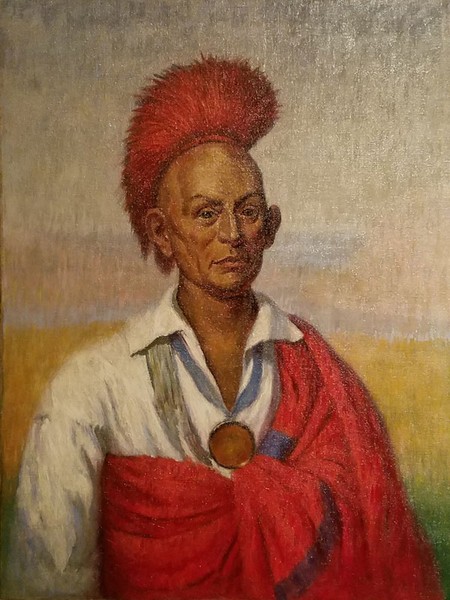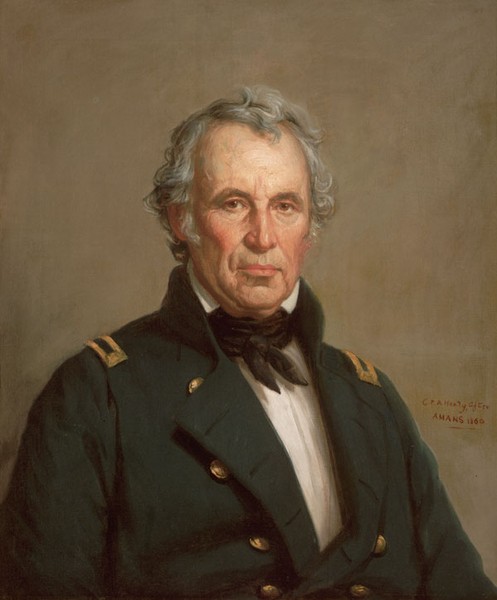Battle of Credit Island
Introduction
Text-to-speech Audio
Images
Credit Island War of 1812 Memorial

Sauk Chief Black Hawk, who led Native and British forces during the Battle of Credit Island

Zachary Taylor, pictured here later in life

Backstory and Context
Text-to-speech Audio
In the early 19th-century, the United States and Great Britain clashed for the second time in less than forty years. The War of 1812 was fought on the fringes of the nation: along the Canadian border, Atlantic Coast, Gulf Coast, and the American frontier. In the west, the United States and Great Britain fought for control of the Great Lakes and Upper Mississippi River region, in part due to lucrative fur trade with Native-American tribes such as the Sioux, Fox, Ojibwa, Sauk, Kickapoo, and Winnebago. With far better goods to offer, Great Britain was able to dominate trade with these tribes, who in turn allied with the British during the War of 1812. Much of the trade in the Upper Mississippi River region centered around Prairie du Chien, a large inland trading center near the Mississippi River in what is now southwest Wisconsin.
Hoping to secure a foothold in the region and cutoff trade between local tribes and the British, a small detachment of U.S. forces began constructing a fortification at Prairie du Chien dubbed Fort Shelby in the summer of 1814. Before the fort could be fully constructed, however, British forces surrounded the garrison and forced its surrender. An American relief column sent north to assist Fort Shelby was defeated by on July 22, 1814 by 400 British-allied Sauk, Fox, and Kickapoo warriors at the Battle of Rock Island Rapids.
The fall of Fort Shelby and defeat at Rock Island Rapids prompted the United States to send another expedition north to capture Prairie du Chien in August 1814. Comprised of 334 U.S. regulars and militiamen, the American force was led by Major Zachary Taylor (future Mexican War hero and U.S. president). Major Taylor's force journeyed up the Mississippi River via eight large river boats.
On September 4, a powerful storm forced the American expedition to stop for the night at Pelican Island, adjacent to Credit Island in the Mississippi River (now near Davenport, Iowa). Two of the boats tied down on the island to weather the storm. As the sun rose on September 5, it became clear that a number of Native American warriors had swam from Credit Island to Pelican Island during the night, killing an American sentry in the process. These Native forces were led by Sauk Chief Black Hawk and numbered between 800-1,200. Accompanying the Indians were several dozen British soldiers, who brought along a 3-pound artillery piece and two swivel cannons (small, portable guns). As Black Hawk recalled, he and his men "resolved to fight--as we had not yet had a fair fight with the Americans during the war."[2]
U.S. forces disembarked from their gunboats and forced the Native attackers off Pelican Island, and Major Taylor ordered one of his boats to guard the channel between Credit and Pelican Islands to prevent more intruders. British artillery opened up from the west bank of the Mississippi, however, and their fire punished the American flotilla. Taylor admitted that the "boats were entirely exposed to the artillery."[1] Black Hawk noted, "We were pleased to see that almost every fire took effect, striking the boats nearly every shot."[2] Under heavy fire an hour, Taylor ordered his forces to retreat downriver. A council of war determined the should continue their retreat. U.S. forces suffered three killed, eight wounded.
Major Taylor's repulse at the Battle of Credit Island (which ironically was primarily fought on Pelican Island and in the open river) marked the last attempt by Americans to secure the Upper Mississippi River region. The War of 1812 ended several months later.
In the late 19th century, Credit Island became an amusement park. In 1918, the City of Davenport purchased the island, and it is now a community park. In August 2014, during the War of 1812's bicentennial, the City of Davenport unveiled a historical marker on Credit Island that acknowledges the little-known 1814 battle.
Sources
1. William A. Meese. "Credit Island, 1814-1914: Historical Address Delivered on the Island at the Celebration of the One Hundredth Anniversary of the Battle." Journal of the Illinois State Historical Society. Vol. 7, No. 4 (Jan., 1915): 349-373.
2. Black Hawk. Life of Black Hawk, Ma-Ka-Tai-Me-She-Kia-Kiak. Edited by Milo Milton Quaife. Chicago: Lakeside Press, 1916.
3. Chris Espenshade. "The Forgotten Battle: The 1814 Battle of Credit Island, Iowa and Illinois." April 22, 2013. War of 1812 Archaeology. Web. Accessed October 24, 2020. http://warof1812archaeology.blogspot.com/2013/04/the-forgotten-battle-1814-battle-of.html
4. "Credit Island Battlefield and the War of 1812." August 17, 2016. State Historical Society of Iowa. Web. Accessed October 24, 2020. https://iowaculture.gov/history/blog/credit-island-battlefield-and-war-1812
5. "200th Anniversary of Battle of Credit Island." August 11, 2014. The Rock Island Dispatch Argus. Web. Accessed October 26, 2020. https://qconline.com/news/local/th-anniversary-of-battle-of-credit-island/article_03dd3dcd-12a2-5116-89b2-a32b5eac6abb.html
James C. Orvis, Wikipedia: https://en.wikipedia.org/wiki/Credit_Island#/media/File:Iowa_-_Davenport_(War_of_1812_Memorial,_Credit_Island),_Scott_County_September_1,_2014.png
State Historical Society of Iowa: https://iowaculture.gov/history/blog/credit-island-battlefield-and-war-1812
State Historical Society of Iowa: https://iowaculture.gov/history/blog/credit-island-battlefield-and-war-1812
